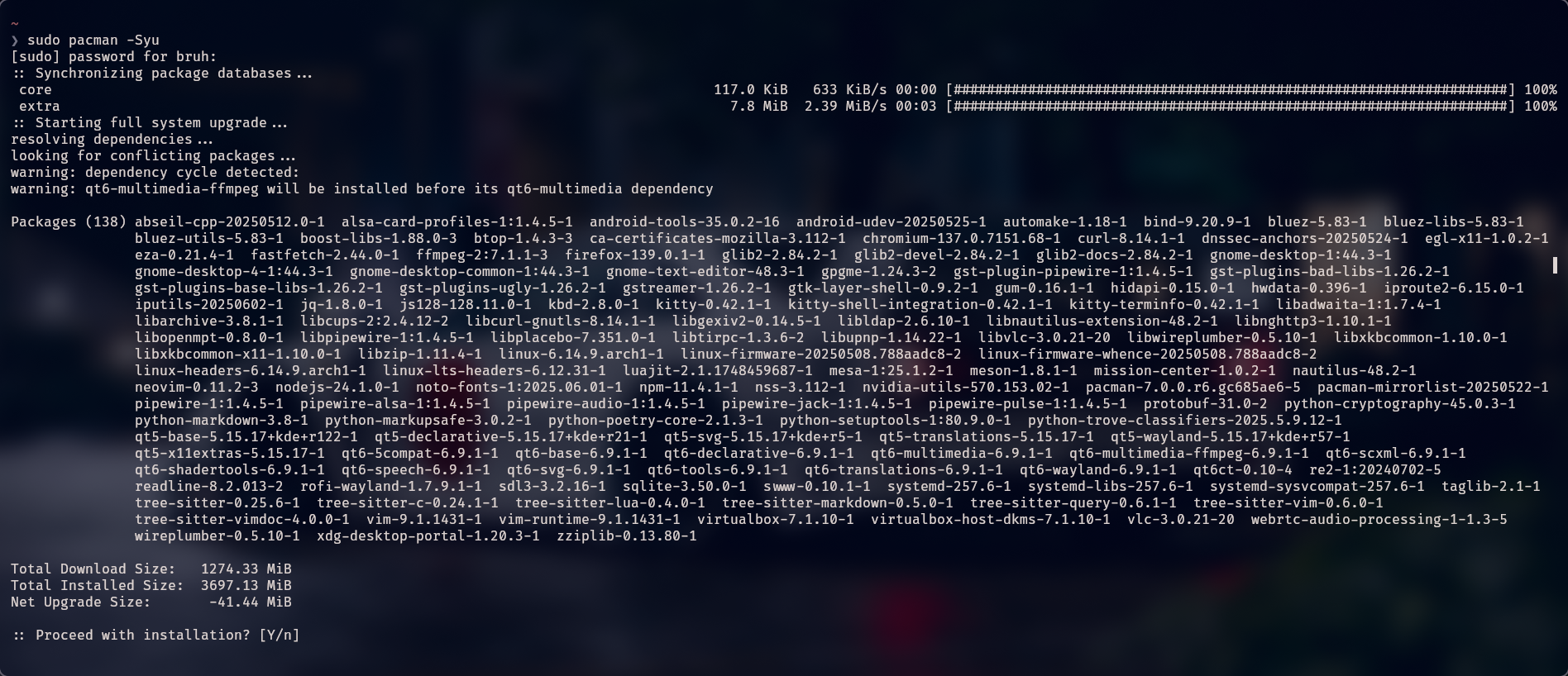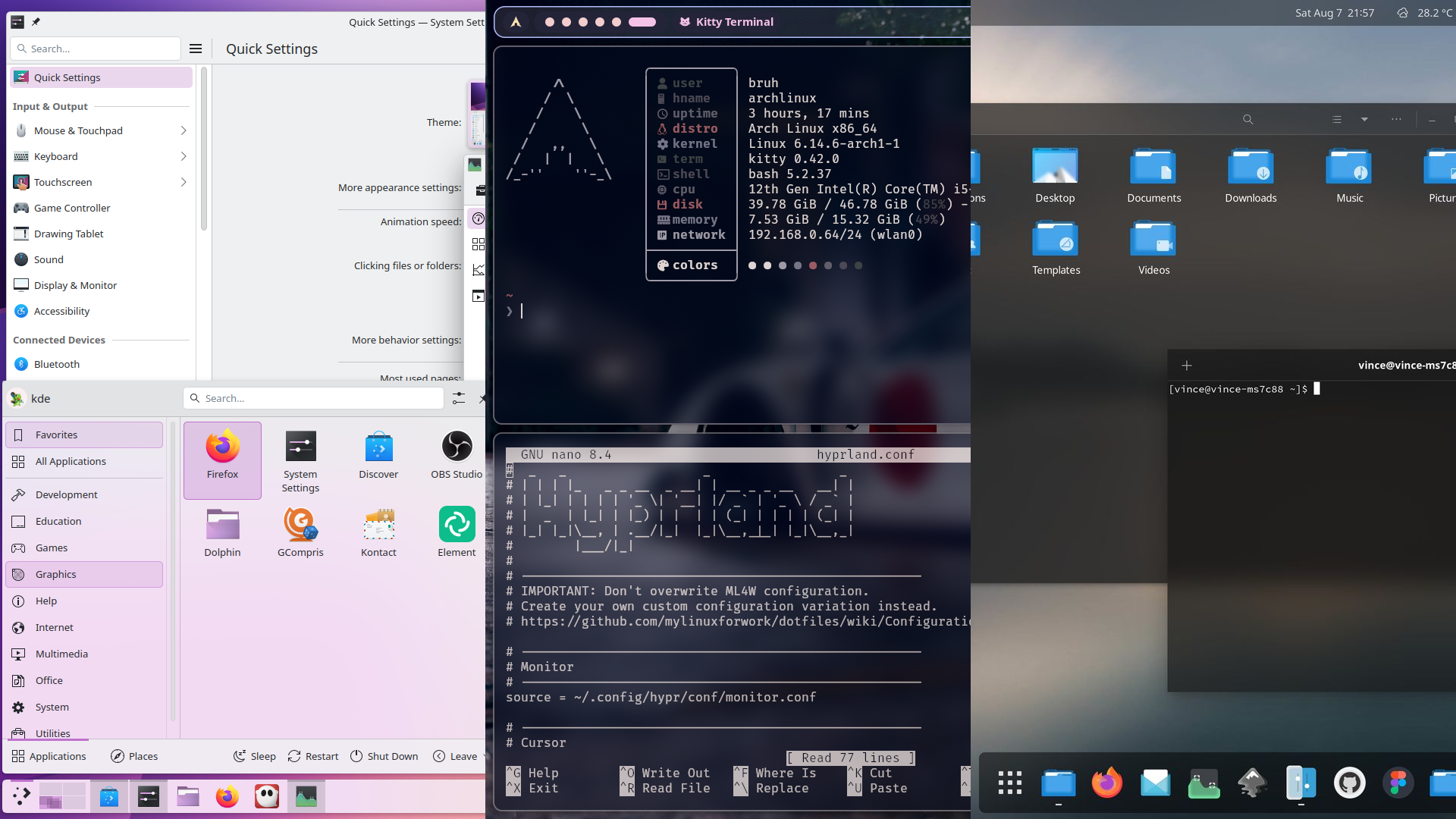Three Years with Arch Linux: A Power User's Perspective

When I first installed Arch Linux three years ago, it wasn’t just another distribution - it was a commitment to a philosophy. Arch isn’t for everyone, but for those who resonate with its principles of simplicity, transparency, and control, it becomes more than just a distribution. It becomes your distribution.
Installation: A Rite of Passage
.png)
Arch doesn’t hold your hand during installation - and that’s a feature, not a bug. The installation process is deliberately minimal, serving as your first lesson in understanding how Linux systems are built from the ground up. From partitioning disks with fdisk to setting up systemd-boot or GRUB, every decision is yours. My first install took hours, from connecting to a network using iwd, to finally typing reboot and pulling out that USB. Now, I can get a minimal Arch system up in under 30 minutes - exactly the way I want it.
For those who value reproducibility, scripting the installation with archinstall2 or tools like Ansible has become a norm, turning manual steps into code and provisioning into automation.
Rolling Release Done Right

Arch’s rolling release model is its crown jewel. With regular pacman -Syu updates, my system remains bleeding-edge without compromising stability (for the most part). That said, it’s not fire-and-forget: I’ve broken my system a few times due to kernel updates, misconfigured packages, or, most commonly, partial upgrades. But the Arch Wiki is practically a sacred text — clear, accurate, and community-maintained. Every issue I've faced had a documented solution.
Arch teaches you to read, understand, and own your system. And when things break, it's not frustrating — it's educational.
The Pacman Ecosystem
Arch’s package manager, pacman, is lightweight, fast, and scriptable. With it, managing software becomes trivial. Combine it with the AUR (Arch User Repository), and suddenly you're installing everything from google-chrome to obscure dev tools with a single command (yay -S <package>). A combo as powerful as Batman and Robin. The AUR is community-driven and surprisingly well-maintained. I’ve encountered fewer broken PKGBUILDs than I expected. I've very rarely found myself looking for packages or applications outside this ecosystem.
Dependency resolution is solid, and the package availability often beats official repos of bigger distros in terms of update speed and variety.
Customization and Control

No distro gives you the level of control Arch does - because no distro makes fewer assumptions. You pick your init system (though systemd is the default), your desktop environment (or none at all), your kernel, and even your fonts and locales. For a tinkerer or developer, it’s paradise.
Over the years, I’ve experimented with KDE, Xfce, Gnome, i3 and most recently, Hyprland — sometimes all on the same machine. Need a real-time kernel for audio production? Done. Need a hardened profile for security research? Just follow the wiki.
Arch is a blank canvas. It reflects you.
Stability and Maintenance
Arch might have a reputation for being unstable because it’s a rolling release, but that hasn’t been my experience. As long as you stay updated and pay attention to system changes, things usually run smoothly. In three years, I’ve rarely had serious problems.
Arch doesn’t protect you from mistakes — but that’s part of the learning. When something breaks, it’s almost always fixable, and you often learn something useful in the process.
It’s a good idea to set up backups or use snapshot tools like Btrfs or Timeshift if you store valuable data, else you might need to re-install. Personally, I’ve only needed to re-install arch once — when I messed up a graphics driver install.
Documentation: The Best in Linux
No other distribution comes close to the Arch Wiki. It’s vendor-agnostic, deeply technical, and frequently updated. Even users of Ubuntu or Fedora rely on it. Whether it’s setting up a hybrid GPU, enabling zram, or tuning systemctl settings, the documentation is consistently reliable. That alone is a reason to try Arch.
Who Should Use Arch?
If you:
- Want to understand how Linux works under the hood
- Prefer full control over your OS
- Don’t mind getting your hands dirty
- Want bleeding-edge software without waiting
Then Arch is a natural fit. If you want a system that just works out of the box with GUI installers and minimal maintenance, you might be happier with Ubuntu, Manjaro, Mint or Fedora.
The Downsides of Using Arch
While I love Arch, it's definitely not perfect. Here are some real drawbacks that anyone considering it should know:
Steep Learning Curve
Arch assumes you know what you're doing. From the moment you boot into a live USB with nothing but a terminal, its made clear. It doesn’t guide you, expecting that you’ll read the docs and figure it out. If you’re new to Linux, this can be overwhelming.
Breakage Can Happen
Not complete installation breakages, but quite often certain packages or applications can break most commonly due to partial updates. These happen when some packages are updated while others are not, especially when mixing packages from the official pacman repositories with those from the AUR via tools like yay.
Not Ideal for Production Machines
For servers, critical workstations, or systems that need 100% uptime, Arch can be risky. There’s no Long-Term Support (LTS) guarantee, and upstream changes come fast. I wouldn’t run Arch in a corporate or client-facing environment unless I was okay with doing frequent manual maintenance.
Final Verdict
After three years, Arch hasn’t just changed how I use Linux — it’s changed how I think about computing. It’s made me a better troubleshooter, a more careful user, and a more confident developer. It respects your intelligence and rewards your curiosity.
Is it perfect? No. But is it worth it?
Absolutely.
🧑🏫 About the Authors
By Yaashvin S V
Yaashvin S V is a dedicated Full Stack Application Developer currently pursuing his B.Tech in CSE. As a true power user who thrives on control and customization, Yaashvin delves into his extensive experience with Arch Linux in this article, sharing the insights and lessons learned from three years of leveraging this powerful operating system.
Related Articles
Subscribe to My Newsletter
Stay updated with my latest articles, projects, and exclusive content.
By subscribing, you agree to our Privacy Policy. You can unsubscribe at any time.
 LinkedIn
LinkedIn
 GitHub
GitHub




-(1).png&w=3840&q=75)

.png&w=3840&q=75)